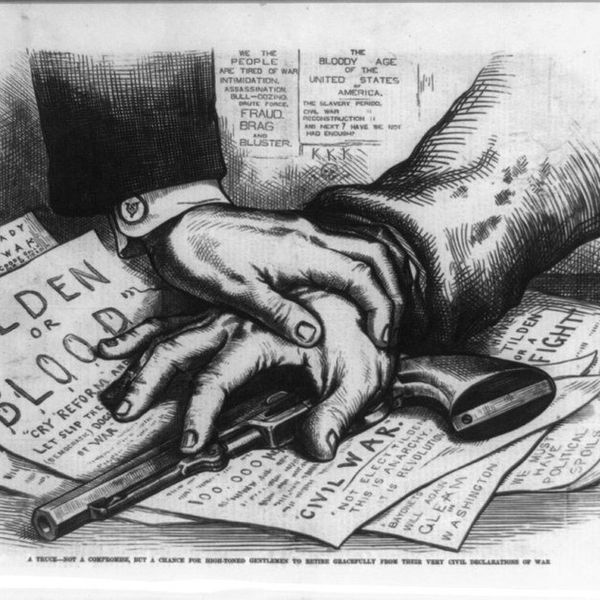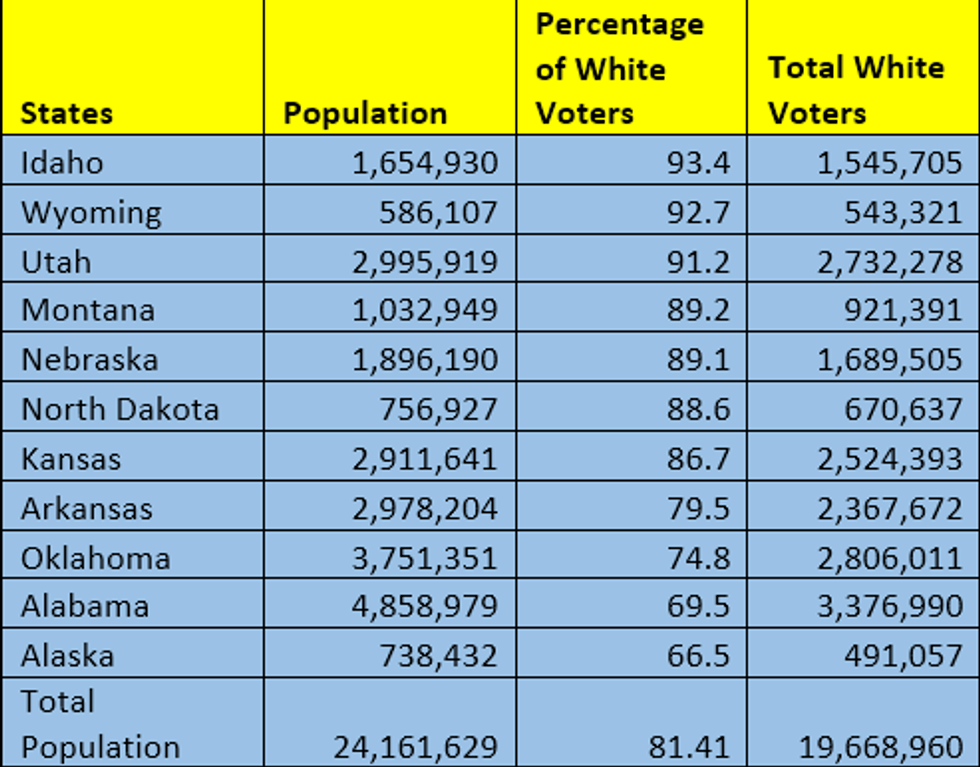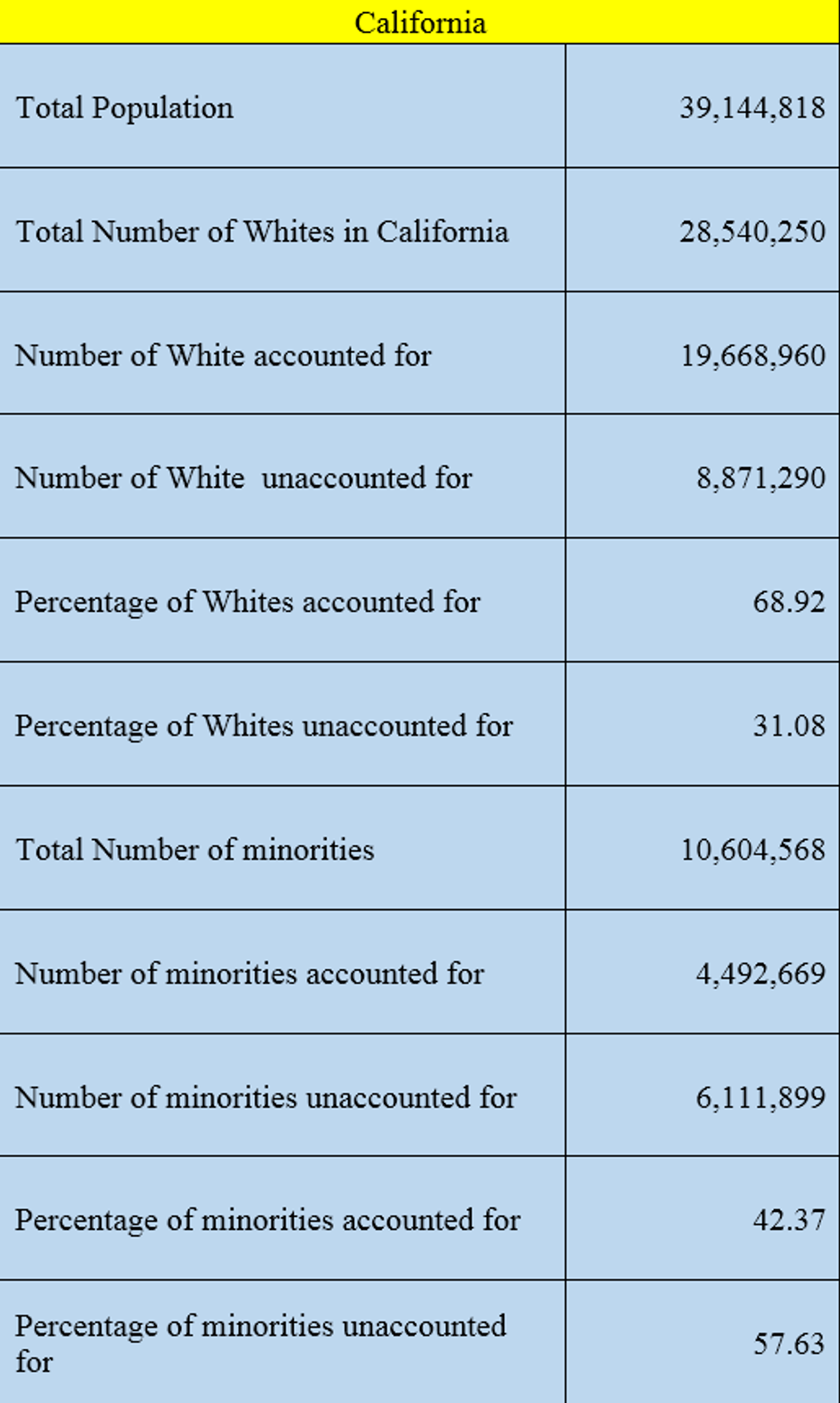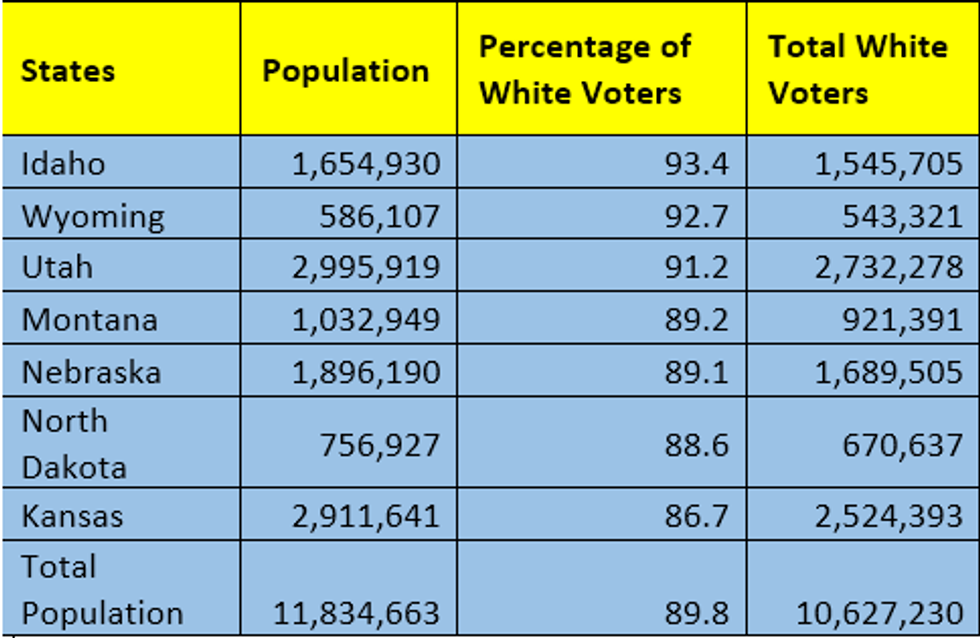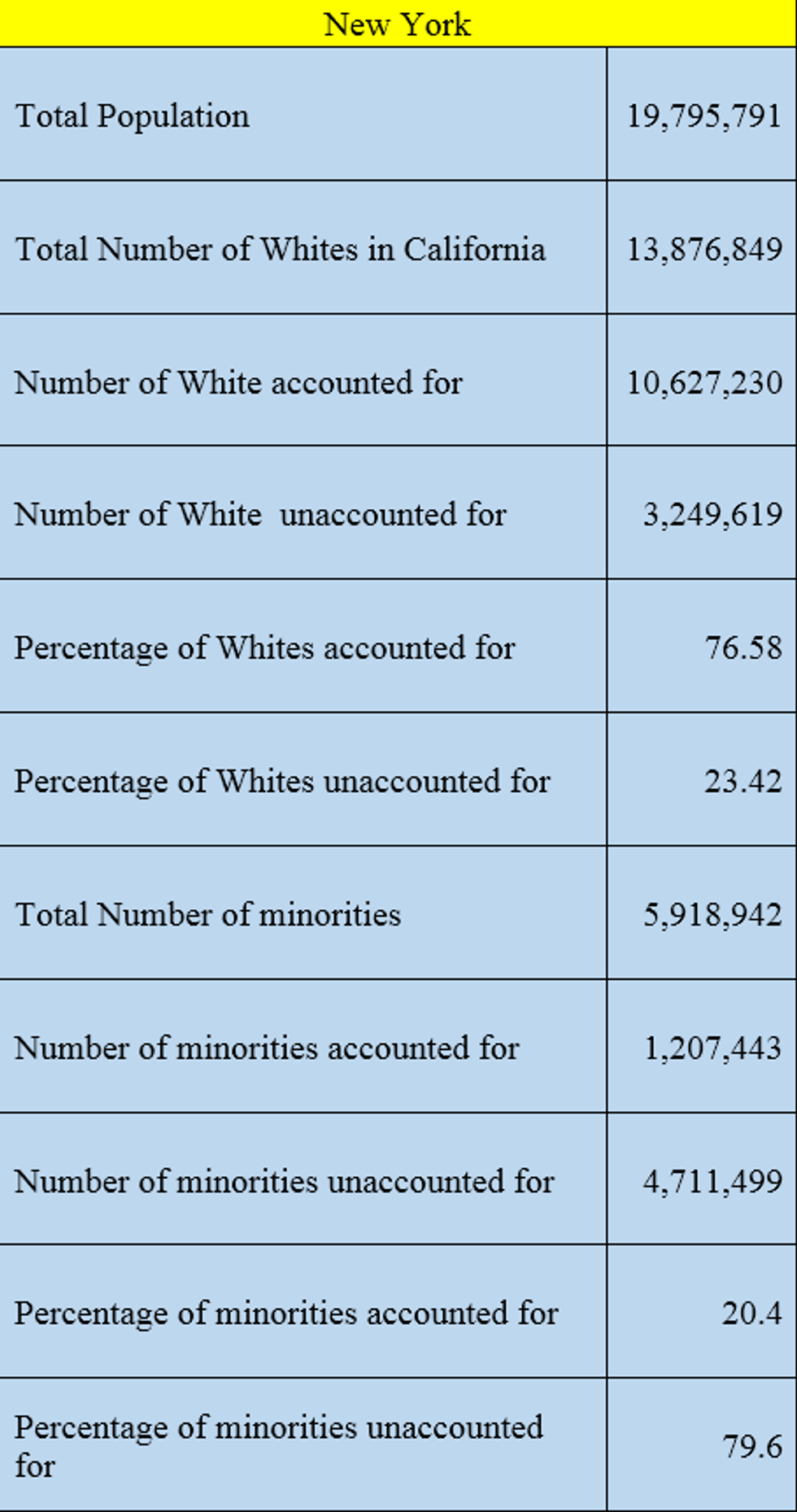There are many arguments made for the Electoral College. A majority of them are stupid and completely out of date. The one I hear many people repeating, whether they are a Republican, a Democrat or an Independent is, “The Electoral College protects the minority from the tyranny of the majority.”
I’ve been hearing that argument every day since the election and it really annoys me. While sitting in class, someone repeated that same, tired argument, and I told him it was BS. While I had an idea of why his logic was flawed, I didn’t have the evidence with numbers to back myself up. I decided to do some research and write this piece to shut down that argument once and for all and prove the Electoral College is still, in fact, very racist - as the founding fathers intended it to be.
I want to make this very clear, I am not writing this in reaction to Hillary Clinton winning the popular vote yet losing the Electoral College. I am not arguing that the results should be overturned. Donald Trump won the presidency legitimately with the system we have. The U.S. Constitution prohibits Ex-Post Facto Law. For those of you who don’t know what "Ex-Post Facto Law" is, in simple terms, if a law is passed that made an action that was previously legal into a crime, you can be punished for that action although you committed that action prior to it being illegal. While this is not Ex-Post Facto Law, I believe the same principle should apply.
Whether you like it or not, and trust me, I don’t like it, Donald Trump won under the current rules we have. Our collective lack of misunderstanding of the Electoral College system is what got Donald Trump elected. We can't continue to call ourselves a Democracy, or even a Representative Democracy, with an Election process that is completely undemocratic. All we can do now is make sure we get a clear understanding of how the Electoral College actually works so we can change the system for future elections.
In order to understand the fallacy that “The Electoral College protects the minority from the tyranny of the majority,” we must first understand who the majority and the minorities are. America racial demographics break down as follows, According to the US Census:
I’m not sure if people forgot, but minorities are nonwhites. It is very important to understand that because it seems as if a majority of people forgot. In order for us to understand if the Electoral College actually protects minorities from the tyranny of the majority, we need to understand who is the largest voting bloc (the majority), and who the smaller voting blocs are (the minorities).
While everyone living in America aren't necessarily registered voters, or even eligible to vote, the voter demographics and the registered voter demographics are essentially the same. In the U.S., there are roughly 218,959,000 eligible voters. Of eligible voters, roughly 67 percent of them are registered, voters or 146,311,000 people. Now I’m going to break down the voter blocs in America. As mentioned, there are 146,311,000 registered voters in the America. 29 percent of those voters are Democrats, 26 percent of those voters are Republican, while 42 percent of registered voters are Independent. Those numbers, while true, on their own, are massively misleading.
As you may have known, most Independents vote for one of the two major parties. 16 percent of Independents lean Democrat, 14 percent of Independents lean Republican and 12 percent of Independent are truly Independent. True Independents sometimes vote Democrat, other times they vote Republican or may vote for one of the various Third Party choices. Those numbers would translate to a 45 percent Democratic lean, compared to the 40 percent Republican lean. In terms of voters, that would translate to roughly 65,839,950 Democratic voters compared to only 58,524,000 Republican voters.
So that’s it, right? The Electoral College protects the Republican minority from the tyranny of the Democratic majority, correct? I will quote Donald Trump here “Wrong.” Again, I ask the question, who are the minorities? That doesn’t become completely clear until I break the numbers down further. Of the registered Democratic voters, 60 percent of them are White. Of the registered Republican voters, 89 percent of them are White. In terms of voters, that would break down as follows: There are approximately 52,086,716 White Republican voters compared to 39,503,970 White Democratic voters.
As you can see, white people make up a majority of both parties because white people are the overwhelming majority of the country at the moment. We need to look at how minorities vote to see if they are actually being represented by the Electoral College. I am considering minorities as all nonwhites. Minorities represent 40 percent of Democratic voters while only representing 11 percent of Republican voters. Furthermore, approximately 80.3 percent of minority voters are Democratic voters, or approximately 26,335,980 voters of the 32,773,264 total minority voters. The Electoral College does not protect the real minorities (nonwhites) from the tyranny of the majority. While by definition, white Republican voters are not the majority, because they are less than 50 percent of the vote, they are by far the largest plurality if we are talking about the popular vote.
The Electoral College makes the white Republican plurality a de facto majority. In no way, shape, fashion or form are actual minorities protected under our current system. It, in fact, assures actual minorities will be less accounted for than their white counterparts.
It is essential that I explain the makeup of the Electoral College for you to understand how it works. In America, we do not directly elect the president. America has a winner-take-all, or first past the post, Electoral College system during its general election. The Electoral College has 538 electors. The Electors consist of 435 members of the House of Representatives, 100 members of the Senate and 3 electors from the Districts of Columbia. There are 50 states in America. Each state has a number of electors supposedly based on population. The bigger the state’s population, the more electors that state has, the smaller the state’s population, the fewer electors that state has. Every 10 years, the number of electors in a state may fluctuate (rarely does) based on census data. The candidate that wins a particular state gets all of that state's electors, while the candidate that loses gets none. A candidate becomes president when he or she receives 270 Electoral votes, which is a little more than half of the total electors.
One of the myriad of issues with the Electoral College is that the states with larger populations, for the most part, have much larger percentages of minorities and are under-represented. Let’s look at California and New York which are large, safely democratic states, as examples. California has 55 Electors for 39.15 million people. New York has 29 Electors for 19.8 million people. California gets one elector per every 711,818 people. New York gets one per every 682,758 people. Let’s compare this to smaller, Republican states like Nevada and Wyoming. Nevada has 6 Electors for 2.9 million people. Wyoming has 3 Electors for 586,100 people. Nevada gets one Elector per every 483,334 people. Wyoming is much worse. Despite being the smallest state in America, in term of population, they by far get the most representation. Wyoming gets one Elector for every 195,333 people. In fact, Wyoming is the reddest state in the country. The small red states, which contain the majority white Republicans, are overly represented in the Electoral College. Meanwhile, the states with a larger population that contains a higher percentage of minorities are grossly underrepresented.
Let’s put this in perspective. Idaho (4), Wyoming (3), Utah (6), Montana (3), Nebraska (5), North Dakota (3), Kansas (6), Arkansas (6), Oklahoma (7), Alabama (9) and Alaska (3), are the reddest states in America. These states have a combined 55 Electors. Their combined population is 24,321,616. In those states, nearly 82 percent of the people are white, while 18 percent are minorities. Since these states are red states, with the winner take all system we have, essentially all those votes are Republican votes.
California’s population of 39.15 million is made up of roughly of 72.9 percent white people and 28.1 percent minorities. This is more than 10 percent higher than in Republican states. That breaks down to 28,540,250 white people in California, compared to 10,609,750 minorities. The large minority group makes the state heavily Democratic. Even in the most liberal places in America, there is no Democratic majority without minorities. In California, 43.9 percent of registered voters are Democrat. This amounts to 7,932,373 registered Democrats. There are 28.9 percent registered Republicans. This amount to 5,225,675 registered Republicans. Once you get rid of the nonwhite minority voters from both parties, this amounts to 4,648,181 registered Republicans compared to just 4,759,424 Democrats. While the Democrats still maintain the slight edge, in purely Democratic vs. Republican total, the Democrats in California do not necessarily have the overall edge because of the 12 percent True Independents, which is roughly 2.2 million votes. In California without the minority vote, California is significantly more likely to be a Republican state.
You may be wondering why I decided to remove the minority vote completely from California. In the 11 reddest states in America, there is a population of over 24 million people, 19.67 million of which, or nearly 81.4 percent are white. The minorities in those states make up 18.6 percent of the population.
The Electoral College claims to “protect the minority from the tyranny of the majority.” The minority are, in fact, nonwhites who are 80.3 percent Democratic. Since those 11 aforementioned Republican states have the same voice as a much larger Democratic states with significantly more minorities, over 15 million people are not being accounted for in California, a majority of whom are nonwhite. California has a 72.9 percent white population. If the demographics of the reddest states were replicated, 68.92 percent of whites would be completely accounted for while 31.08 percent of whites wouldn’t be accounted for. This is horrible. However, when we compare that to nonwhites, the picture looks quite a bit rosier. Only 42.37 percent of nonwhite voters are completely accounted for, compared to 57.63 percent of nonwhites unaccounted for in California.
The same thing can be done for a state like New York, which has a higher percentage of minorities than California. New York has 29 Electors. The reddest states do not add up to 29 electors, however, they add up to 30 electors. These states are Idaho (4), Wyoming (3), Utah (6), Montana (3), Nebraska (5), North Dakota (3), and Kansas (6). Their states have an 89.8 percent white population with 11.8 million total people, 10.6 million of whom are white. See below:
New York gets 1 less Elector for 8 million more people. New York is populated with 70.1 percent whites compared to 29.9 percent nonwhite minorities. If we replicate the demographics for the seven reddest states for New York, here’s how New Yorkers would be represented:
Under the current Electoral College system, 79.6 percent of nonwhites are not accounted for in one of the most diverse states in America. Meanwhile, 76.58 percent of white voters are accounted for. The Electoral College makes states with virtually no minorities, have a larger voice and more representation than states with a big minority population. States with a large percentage of minorities are nearly completely unaccounted for. The Electoral College allows the reddest states with a very small percentage of minorities, matter nearly 1.9 times more than New York, a state with a relatively high percentage of minorities. This is much worse for states like Maryland, which has a larger percentage of nonwhite minorities.
Let’s revisit this supposed reason for the Electoral College. People say “Electoral College is to assure that the minority is protected from the tyranny of the majority.” White Republicans are in no way the minority. In fact, white Republican voters are the plurality and the de facto majority because of the Electoral College. Here’s something to consider, 80.3 percent of nonwhite voters are Democrat or Democratic-leaning. If the Electoral College was meant to protect minorities, why has 40 percent of the elections since 2000 not benefitted the party that most of the actual minorities are a part of? The Electoral College only benefits smaller states and disadvantages larger states. Even when looking at the Democratic small states, there are a higher percentage of Republicans in those blue small states than there are Democrats in the red small states. The Republican party, which is overwhelmingly white, benefits more from the Electoral College in every way.
The Electoral College has to go. It is a disastrous system that benefits the plurality of white Republicans while making them the de facto majority. I completely understand that the Republican party, as it has been for the last 50+ years since realignment, is dying out and you don’t want liberals to affect your way of life. However, it is not right that the largest plurality has more say in the Election that what majority of America wants. Your state sovereignty is protected when you vote for local officials, and the Constitution protects you from any unconstitutional acts. But the minority although a plurality of people should not have the right to decide how the entire country should be governed. In a National Election, where everyones voice is supposed to matter, we cannot have an Electoral College that assures that minorities have a lesser voice in the democratic process.
Furthermore, the Electoral College creates a system where only the 11 swing states matter in the election. If you live outside of the 39 swing states, your vote does in any way determine the election. The popular vote, which I don’t necessarily think is the most effective system, is significantly better that the First Past the Post Electoral College system we have now.
Evidence today, proves the Electoral College is still racist, and I didn't even talk about the historical evidence that proves the founding fathers meant for the Electoral College to be racist with the creation of the Senate. In fact, Constitutional Scholars say, "the Electoral College is a 'vestige' of slavery." I will assume most of you don't know more about the constitution than most constitutional scholars. You can click here to read more about that.
There are several more effective systems other than the Electoral College, First Past the Post system that would force the presidential candidates to represent everyone and would make your vote actually matter more than what state you are in. If you would like to know what system(s) I have in mind other than the Electoral College and the Popular Vote, you can click the Facebook and Twitter buttons below and to follow me so you see my next article.
What upsets me most about this election is that Republicans and Democratic loyalists have shown what big hypocrites they are. Republicans say they want their vote to matter and the Electoral College represents them. By saying that, they are also saying they want their voice to matter more than anyone else's and especially more than the minorities they claim to want to protect. Democrats now only want to change the system because their candidate lost. There is zero principal behind it. Republicans and Democratic loyalist disgust me and you all should be ashamed of yourselves for behaving like you're six.


